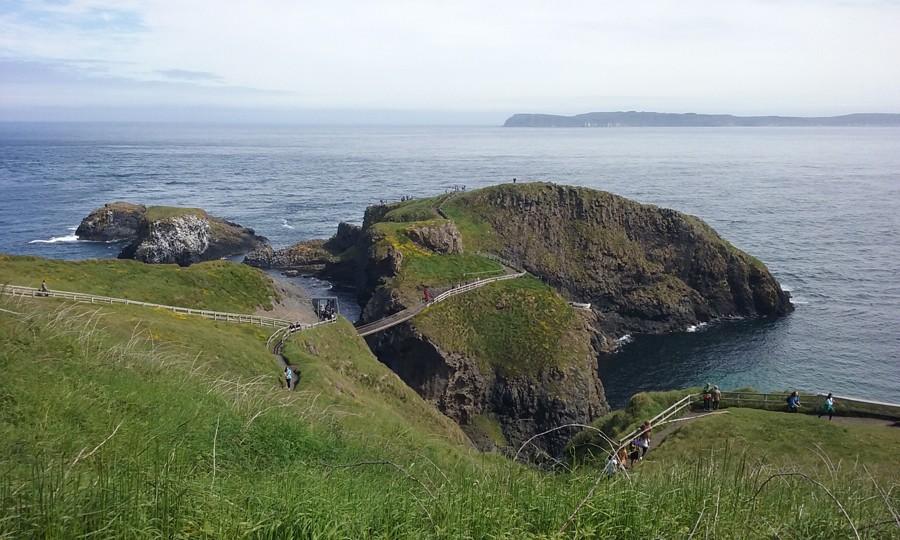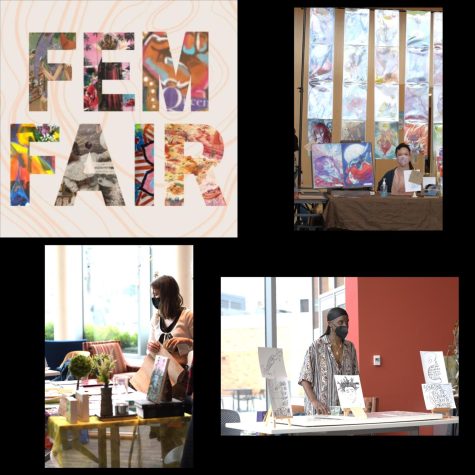A grand adventure
Carrick-a-Rede rope bridge in Northern Ireland connects this tiny island to the mainland.
September 19, 2015
Two days after I handed in my last final paper, I found myself face to face with a customs agent. After hauling my luggage through MSP and Atlanta, crossing the Atlantic, and eating what Delta claimed was beef stew, but I suspected was canned dog food, I arrived in Dublin, Ireland feeling completely exhausted. I touched down without knowing a single person in this foreign country, and the enormity of my decision to stay for two months was just starting to sink in as the customs agent stared at me.
He gave me the all-clear after I produced several sheets that’d been shoved into my carry-on, and as I walked through the airport I realized just how little I knew about the country I’d be staying in. Signs overhead proclaimed “Fáilte go hAerfort Bhaile Átha Cliath,” and then, below, the English translation: “Welcome to Dublin Airport.” I later learned that Irish (or Gaelic, as it’s known in the U.S.) is a mandatory course in school, but most Irish people can’t speak it fluently; either way it struck me that this was a place with its own language and customs, and just because they spoke English didn’t necessarily guarantee I’d easily adapt to their culture.
My decision to study abroad and experience two internships in Ireland wasn’t a simple choice—spending several thousand dollars to work for free seemed ridiculous at times. But if every decision was made through weighing the pros and cons, rather than going with gut instinct, I don’t believe many worthwhile things would ever get done. So I chose to take a chance and didn’t look back.
I tried telling myself this philosophy after getting hopelessly lost on a “test run commute” to my first internship. I had told the bus driver my stop; he gave me a blank look and said my stop didn’t exist, then must have decided there was no hope for me and dropped me off at a farm. I had no working cell phone, so Google Maps was out of the question. I glanced around for any possible help, but didn’t see anyone besides a couple of horses flicking their tails. At least I had a vague sense of which direction to head in—time to put that highly extensive, one year stint in Girl Scouts to good use.
After several miles of walking through chilly, damp air that clung to my bones, I regretted wearing brand-new shoes and not having an operational phone. Eventually, though, I found a taxi to take me to my destination: Dundrum Shopping Centre, where Dublin South FM was located.
I had to trek up to the fifth floor of the mall, and my feet were practically raw before I made it to the station door. Since I still had some time before I had to be inside, I plopped down on the floor and wrestled my backpack off. I was sitting on the floor with my hands on my knees in business casual attire when the door opened and my soon-to-be supervisor looked down at me. To his credit, he seemed to take it in stride.
Bob Hallion, newsman and rugby aficionado, showed me around the tiny, blue-gray colored station. “We have tree studios,” he said, gesturing to the left side of the station. Tree? I wondered, my first encounter with Irish people’s refusal to say “th” sounds. I’d be using Studio 3 or 1 for recording, and typing up news broadcasts and answering phone calls in the newsroom on the right side of the station.
“Right. I was just about to record the news,” Bob said. “Want to give it a go?”
Did I want to go on-air, doing something I had zero experience in and that I hadn’t expected to do at all?
“Might as well,” I told him.
The next day, my first official day at the station, I conducted my first interview with a contestant in Ireland’s Best Scone competition. Bob was gleefully telling my other supervisor, Colm Daly, all about how they’d “thrown me to the sharks” within my first couple of days.
“Recorded the news on her first day!” he said. “Fair play to ya,” he added.
I got thrown in the world of radio head-first, but quickly fell in love with it. I enjoyed the fast-paced environment of radio, the way I’d crack up with Bob or the other intern, Sinead, when I mispronounced Irish names, and it didn’t take me long to fall into a rhythm.
I’d read the press releases, type up a broadcast, set up interviews, conduct interviews, record and edit audio files. Of course, this being Ireland, there were several tea breaks in between—I had to fight to keep a straight face when they showed me a kitchenette off to the side whose sole purpose was for making tea and coffee. Some stereotypes are based in truth, I guess.
Whenever I was waiting on a call, I’d go get tea. If there’s one thing I learned in Ireland, it’s how to make hot beverages—I got schooled on how to make instant coffee my first day. I’d stroll back from the kitchenette only to have someone inform me that I had an interview in five minutes. I’d fiddle with the soundboard and “mmhmm” my way through the interview, all while gazing forlornly at the rapidly cooling tea I couldn’t drink.
However, I’d trade any amount of cold tea in exchange for the interviews I snagged. I had the chance to interview Minister of State Dara Murphy, Minister for Communications, Energy and Natural Resources Alex White, and countless other politicians and community leaders. I tried to arrange for an interview with a politician called the Taoiseach, until Bob asked, eyebrows raised practically off the top of his forehead, whether I really expected to get ahold of the head of the Irish government.
One month into my trip, though, it was time for me to start at Vermillion Design/Associated Editions. I’d be working there, in North Dublin, Monday through Wednesday, and stay at DSFM on Thursdays and Fridays. They weren’t exactly sure what to do with me on my first day, so I was stuck putting together boxes. Let me tell you, I can make a mean box fort. But they soon realized that I had more potential as a writer, and had me writing blog posts and book reviews.
Even though I was working full-time, it wasn’t all work and no play. So, on to the good stuff: my non-work experiences.
One nice thing about European cities is they’re full of history and stunning architecture, so there was no shortage of interesting sites to explore.
Over the course of my stay, I had the chance to visit the National Gallery and take illegal photos of Picasso paintings (you didn’t hear that from me), the National Museum of Ireland, where I saw old Viking trinkets and dead people (mummified remains, at least), and Dublin Castle. It’s less Disney castle and more ancient governmental seat, but it was still cool to walk around the grounds. I also visited Dublin Zoo, where I hung out with penguins and my personal favorite animal, the okapi— it looks like a short brown giraffe with a zebra butt.
I also made a trip up to Northern Ireland; a supposedly haunted jail, Bushmills Distillery (distilleries are hotter than the saunas of the underworld, in case anyone was wondering), Giant’s Causeway, and Dunluce Castle (also supposedly haunted) were some of the highlights.
My favorite place didn’t come with a brochure and guided tour, though. Dun Laoghaire is a little coastal town about half an hour outside of Dublin, and has two piers with great ocean views. Being in a landlocked state, I don’t often have the chance to just sit by the ocean, so I appreciated the chance to sit on the rocky shore and decompress for a while. It doesn’t get much more relaxing than eating fish and chips, sipping craft beer, and watching the setting sun sink into the ocean.
However, my adventures wouldn’t be nearly as fun if I didn’t have people to share them with. I got lucky when it came to my roommates, and we made some Irish friends who were happy enough to get drunk and play Mortal Kombat with us (guess college kids are essentially the same wherever you go). They’d mimic our American accents, sounding decidedly Valley Girl-ish, while we tried to imitate them. “Go to the gaff, it’ll be grand, like,” we’d try, only to be scorned for sounding too British.
Overall, I’ll miss the little things: the magpies dotted everywhere like a plague (their version of the campus squirrel), the taxi drivers who never knew where they were going, the way my wallet gradually got weighed down like a brick with Euro coins. I’ll miss walking down to the corner store to get lunch with my coworkers, and the way Irish people say “bye” about 10 times before ending a phone call. I won’t forget how a pigeon crapped on my brand-new jeans while I was walking to work one day, or how I spent the 4th of July, watching “Friends” and eating pizza with the girls and our Irish lads.
The thing I’ll take away from this experience isn’t that everyone should go study abroad. The harsh truth is that studying abroad is incredibly expensive and isn’t the best option for everyone. But what it did teach me is that a change of scenery or a new experience can better you if you’re open to it. The best artists know that a change of perspective can alter a painting dramatically, and the same can be said for everyday life. Sometimes we get stuck in a rut and need to change our daily routine, but going to a foreign country isn’t possible. But maybe going to a different coffee shop or taking the backroads to work is. As summed up by Disney’s “Up”: “Adventure is out there.” So go find it.




Jana McGrath • Sep 20, 2015 at 11:36 am
Hello Jody, I really enjoyed your article! I arrange internships myself here in Ireland and I’m wondering if you had anyone to meet you at the airport and take you on a trial run of your commute? It sounds like you were left very much to your own devices, and you handled things admirably. You really summed up the idiosyncrasies of Ireland!
Ultan • Sep 20, 2015 at 6:04 am
Good call on Dún Laoghaire. My home town. Hope you avoided that Temple Bar mess in the Dublin City Centre though.
One small correction: Gaelic is what they speak in Scotland. We (the Irish in Ireland) speak Irish – which is called “Gaeilge”.